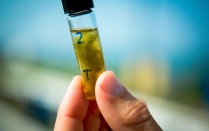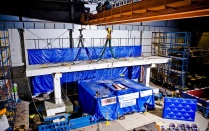Environmental Engineering faculty member and students publish findings on nanomaterials underground and the effect of dimensionality on water treatment

By Peter Murphy
Published May 22, 2018 This content is archived.
An environmental engineering assistant professor published a paper in collaboration with the United States Environmental Protection Agency (USEPA) in the journal of Environmental Science & Technology, and had a student receive lead-author credentials on a paper published in the Journal of Nanoparticle Research.
Nirupam Aich, a faculty member in the Department of Civil, Structural and Environmental Engineering, and his lab group, Aich Laboratory of Environmental Nanotechnology and Sustainability (#AichLENS), recently published papers highlighting different work on nanomaterials.
Aich co-authored a paper, Modeling the Transport of the “New-Horizon” Reduced Graphene Oxide-Metal Oxide Nanohybrids in Water-Saturated Porous Media, with researchers from other universities around the world and from the USEPA. This paper, for the first time, shows how to model the complex behavior of multifunctional nanohybrids in the porous media. Nanohybrids are a class of nanomaterial which is made by combining two or more materials – the goal is to improve their functionality and applications in different fields. Aich and others have provided new ways of modeling the transport behavior of a carbon-metallic nanohybrid set that is made by combining different types of metal nanoparticles (zinc oxide, titanium dioxide, and iron oxide) on to a planar carbon nanomaterial named graphene. You can read the article at this link.
Arvid Masurd, one of Aich’s PhD student, was the lead author on a paper published in the Journal of Nanoparticle Research. Other coauthors include CSEE PhD student Yanbin Cui and assistant professor John Atkinson. Shape matters: Cr(VI) removal using iron nanoparticle impregnated 1-D vs 2-D carbon nanohybrids prepared by ultrasonic spray pyrolysis describes the effect of dimensionality of different carbon nanotubes and graphene on the chromium removal performance of the nanocarbon-iron hybrid materials. In this paper, AichLens, in collaboration with Atkinson’s group, demonstrate the pollutant removal performance of carbon-metallic nanohybrids depend on the shape or dimensionality of the carbon nanomaterial. You can read more about the study at this link.









